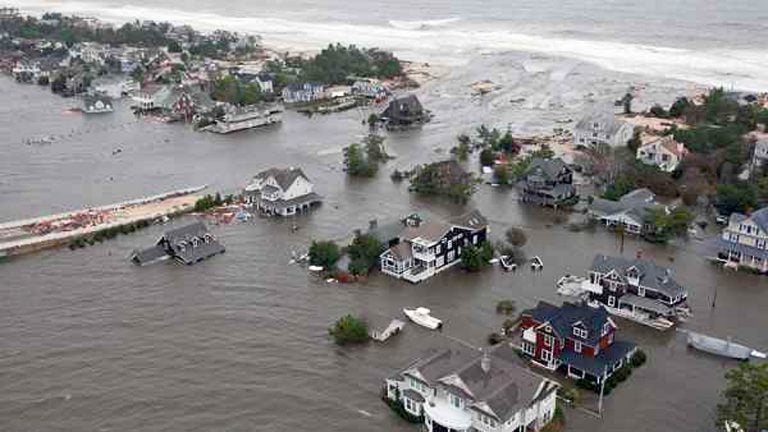Explainer: The National Flood Insurance program

(AP Photo/U.S. Air Force, Master Sgt. Mark C. Olsen)
Extreme storms like hurricanes Sandy and Katrina have introduced a new lexicon into discussions of both politics and policy, with words and phrases like FEMA, flood maps, and the National Flood Insurance Program becoming increasingly common in the public discourse in New Jersey and across the country. But meaningful discussions are only possible when all involved understand and share a common terminology. The National Flood Insurance Program is the logical place to start:
What it is
Managed by FEMA, the National Flood Insurance Program (NFIP) is a federal initiative that helps protect homeowners, renters, and business owners in flood-prone areas throughout the country.
FEMA’s Flood Hazard Mapping Program creates Flood Insurance Rate Maps (FIRMs), (aka “FEMA flood maps”) based upon detailed engineering surveys and risk analyses of both coastal and inland parts of the country at risk of flooding. Those maps basically document the risk and potential severity of flooding and set minimum elevation guidelines for homes and businesses in those areas.
If someone purchases a federal flood insurance policy, the NFIP uses those maps to set its rates, based on whether the structures are in compliance with the elevations and other building standards. Properties raised above the listed elevation for their neighborhood can save money on their annual premiums, while those below may pay substantially more. The goal is to help reduce risk by providing financial incentives for safer construction, as well as by mandating that communities participating in the NFIP adopt baseline flood-plain management regulations.
Part of the reason the NFIP was created was because many private insurance companies stopped offering flood insurance after a series of disasters make it too expensive for them to provide. The issue of adverse selection — where only those who were most at risk purchased coverage — also added to the problem. While private flood insurance is still available through a handful of companies, the vast majority of policies in the United States today are through the NFIP, which issues the payouts, even though private insurance companies are still responsible for the daily operation of the program.
How It Came About
Throughout most of American history, flood control and insurance were not considered responsibilities of the federal government. That began to change with the Flood Control Act of 1917, when the devastation of several large floods combined with a lobbying campaign by landowners along the Mississippi River convinced Congress to appropriate $45 million to the Army Corps of Engineers to build levees along portions of several flood-prone rivers. Though broadcast media were still in their infancy, the Great Mississippi Flood of 1927 and other floods in subsequent decades were covered widely with live dispatches, further creating a perception that such events were national rather than local problems, and thus required more of a national response.
By the 1960s, the formation of such entities as Medicare, Medicaid, and the Interstate Highway System had made the federal government a more visible and active part of people’s everyday lives, and in turn, Americans began to expect more from Washington, including greater assistance when disasters struck.
After Hurricane Betsy hit New Orleans in 1965, causing over a billion dollars of damage, President Johnson took the then-unprecedented move of making a personal visit to the city in the immediate aftermath of the storm, meeting with survivors, and pledging his support for the recovery. Some historians mark this as a turning point in how the government responds to natural disasters, since it then became politically risky for future presidents not to respond in a similar fashion. There was also a growing awareness during this time that the government’s response to storms and floods can’t just be to throw money at the problem after the fact or simply try to reduce the risk with structural measures like dikes and dams. Understanding that more of a holistic, proactive approach was needed, the Army Corps began providing technical assistance to communities to manage development in their floodplains, and in 1968, Congress created the National Flood Insurance Program to set minimum, nationwide standards and provide a safety net for those living in vulnerable areas.
How It Works
In order to obtain flood insurance through the NFIP, an individual must live in a municipality that’s officially become part of the program by adopting a set of baseline flood-plain management regulations. The vast majority of communities in the country — over twenty thousand — are currently members of the NFIP, as is every municipality in New Jersey, with the exception of five: Audubon Park, Fieldsboro, Hi-Nella, Newfield, and South Harrison. Although many people think flood insurance is only needed along the coast, inland flooding in many places can be just as damaging and deadly. NFIP member communities that take steps to surpass the baseline regulations can move up one or more tiers in the Community Rating System, potentially saving their residents as much as 45 percent off their flood insurance premiums.
Among the baseline regulations the NFIP sets are building standards for people in Special Flood Hazard Areas (as defined by FEMA’s elevation maps) whose buildings are “substantially damaged” (more than 50 percent) in storms or who are building from scratch. For example, flood insurance is not available for any building constructed entirely over the water unless it was built before the early 1980s and is grandfathered in. And buildings in the most sensitive “velocity zones,” which are prone to three-foot waves on top of flooding, should be built using unobstructed piers to allow water to flow underneath instead of concrete foundations.
People merely making non-substantial repairs to existing structures in flood hazard areas are not required to follow these regulations, but they’ll ultimately pay more in flood insurance premiums if they do not.
Although the NFIP is run by the federal government, daily operation of the program is handed off to private, so-called “Write Your Own” (WYO) insurance companies, that issue the policies and make the payout determinations, based upon government rules of what is and isn’t covered. Since the payouts are made using federal money, these insurance companies are often audited after major events like Sandy to ensure compliance with all regulations.
Don Griffin with PCI, an insurance industry lobbying group, says part of the reason many storm victims had to wait months before receiving their settlements is because the WYOs were taking extra time to make sure they crossed all their T’s and dotted all their I’s. “Frankly, if it turns out that they paid money they shouldn’t have, then they will be liable out of that company’s pocket,” he explains, “because basically, they have the taxpayers’ checkbook.”
Upcoming Changes
The NFIP is currently $24 billion in debt, largely as a result of payouts from Hurricane Katrina. In order to help put the program on more secure financial footing, Congress passed the Biggert-Waters Flood Insurance Reform Act of 2012, which will make a number of changes, including increasing flood insurance premiums so the rates people pay will more accurately reflect their risk.
Many discounts and subsidies policyholders received in the past are being eliminated, and low, grandfathered rates some people have been paying will be phased out over the next five years. These updates had already been signed into law before Sandy, but the storm has drawn more attention to them, with groups like Stop FEMA Now calling for the act to be repealed, and some political leaders now introducing legislation to tone down the changes or phase them in more slowly so the shock to policyholders isn’t as great.
_____________________________________________________
Scott Gurian is the Sandy Recovery Writer for NJ Spotlight.
WHYY is your source for fact-based, in-depth journalism and information. As a nonprofit organization, we rely on financial support from readers like you. Please give today.




